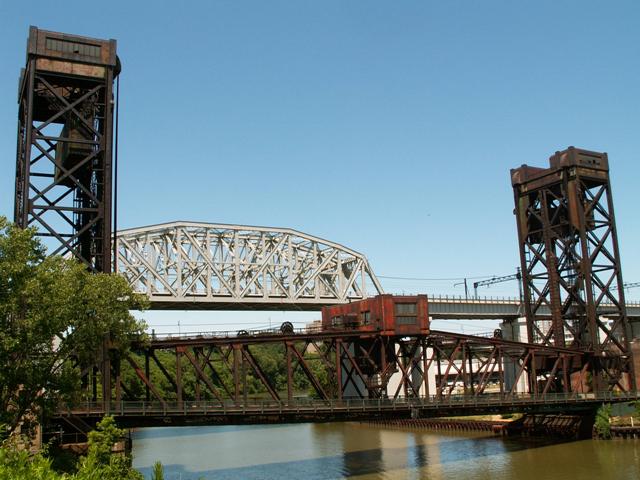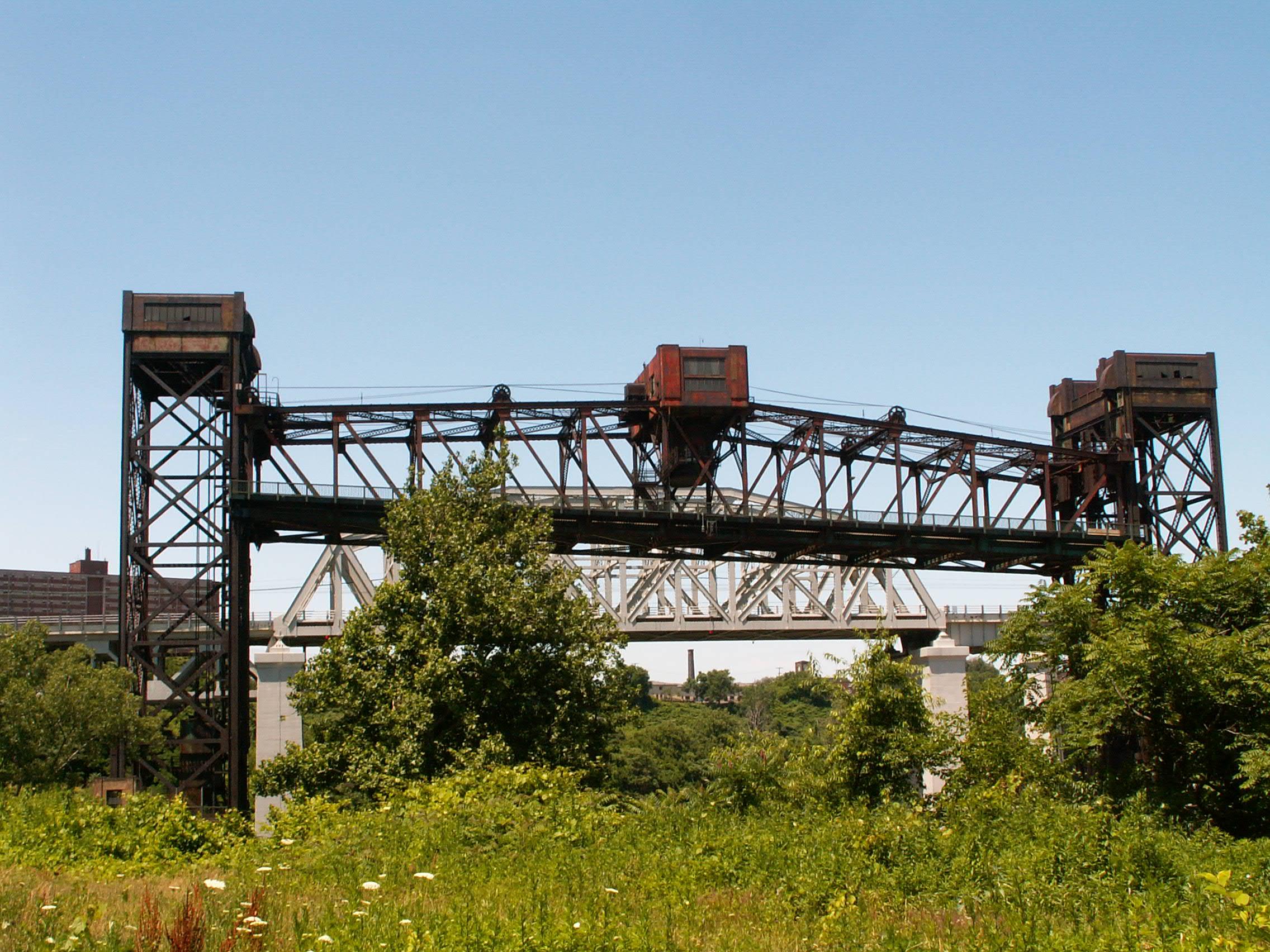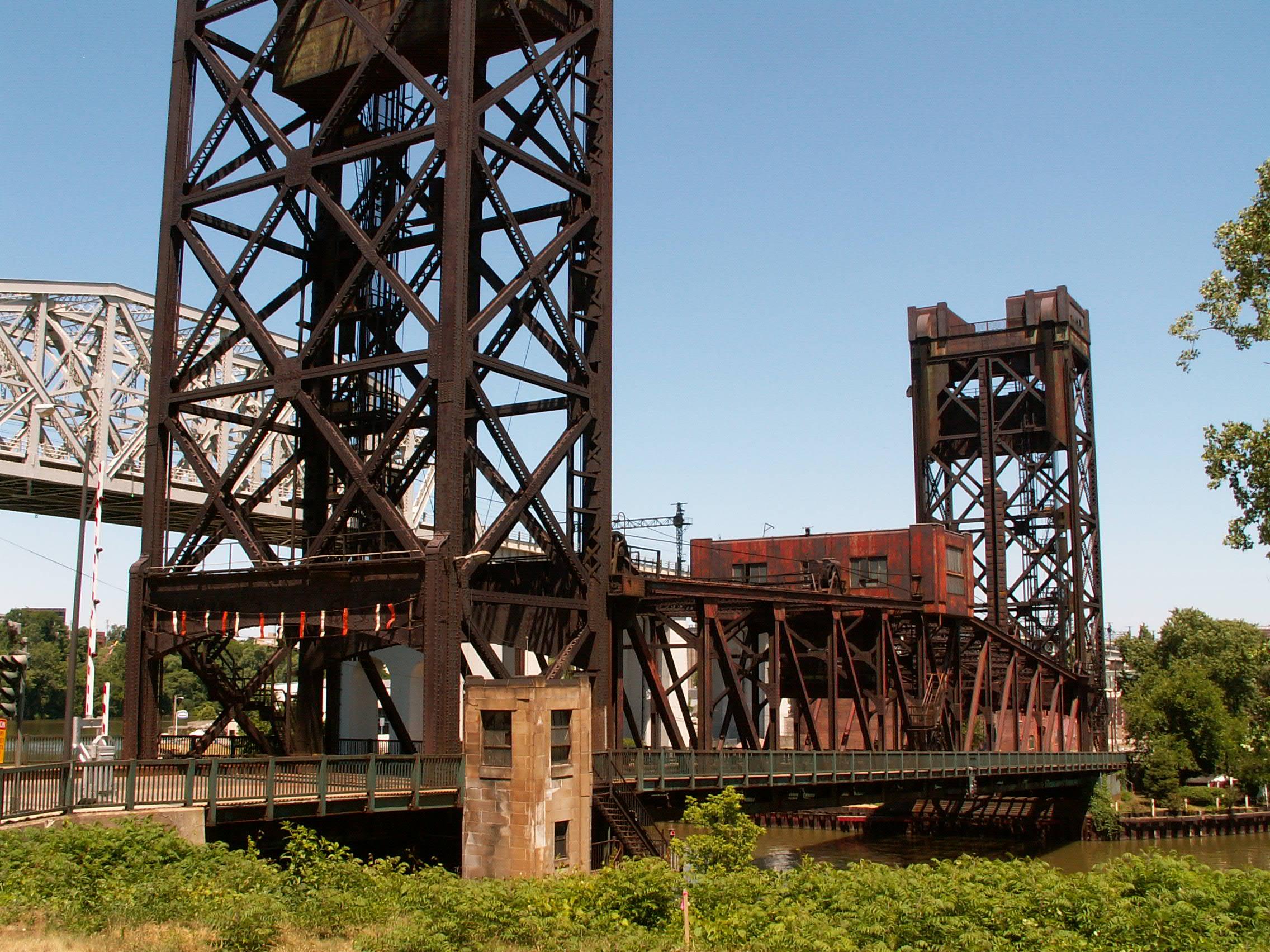We Recommend:
Bach Steel - Experts at historic truss bridge restoration.
BridgeHunter.com Phase 1 is released to the public! - Visit Now
Columbus Road Bridge

Primary Photographer(s): Nathan Holth
Bridge Documented: June 24, 2007
Cleveland: Cuyahoga County, Ohio: United States
Metal 11 Panel Rivet-Connected Camelback Through Truss, Movable: Vertical Lift (Span Drive) and Approach Spans: Metal Stringer (Multi-Beam), Fixed
1940 By Builder/Contractor: Wisconsin Bridge and Iron Company of Milwaukee, Wisconsin and Engineer/Design: Ralph L. Harding of Cleveland, Ohio
Not Available or Not Applicable
220.0 Feet (67.1 Meters)
359.0 Feet (109.4 Meters)
42 Feet (12.8 Meters)
1 Main Span(s) and 4 Approach Span(s)
1833758

View Information About HSR Ratings
Bridge Documentation
This bridge has been altered, resulting in a severe loss of historic integrity and significance!
View Archived National Bridge Inventory Report - Has Additional Details and Evaluation
View Historic American Engineering Record (HAER) Documentation For This Bridge
HAER Data Pages, PDF
View The Original Site Plans For This Historic Bridge
View The Original Shop Drawings For This Historic Bridge
View Historical Articles About This and Other Area Lift Bridges
Much of this historic bridge's superstructure was demolished and replaced in Summer 2013! This bridge no longer has any noteworthy historic value!
Description and Significance of Bridge Prior To 2013 Alteration
This bridge was among the oldest of Cleveland's vertical lift bridges, and this is one reason why it stands out among the other bridges of Cleveland as noteworthy. Furthermore, the bridge does not show the signs of drastic alteration that some of the other vertical lift bridges in the city, such as the bridge found on 3rd Street. However, all of that set aside, the bridge is significant for its highly rare 5% grade that it features. Grades on a bridge, while not rare, are not common either. However to find an movable bridge with a substantial grade like this is quite a surprising find. Cleveland has another, it is the abandoned Eagle Avenue structure, and is is also significant for age grade as well. Thus, the bridge is significant on account of this unusual, and noteworthy design. As if this were not enough reason, the bridge is also significant as a documented example of a bridge funded through Depression relief programs because the plaque on the bridge identifies the Public Works Administration's involvement. Prior to alteration, the bridge was also significant for its lack of alteration. It was an outstanding example of vertical lift bridge technology and was designed by Cleveland-based consulting engineers. HAER names the primary consulting engineer as Wilbur Wilson and Associates of Cleveland, Ohio. The bridge plaque does not list that name exactly, but it does list a Wilbur Watson as a consultant for the bridge design. The plaque also mentions Ralph L. Harding as a consulting bridge engineer. The plans for the bridge bear the name of R. L. Harding as the consulting engineer. What is apparent is that more than one consulting engineer played a role in the design of this bridge.
Contractors and builders apparently did not get much appreciation for building this bridge; the large plaque on the bridge has consulting engineers listed, but no contractors. Generally, movable bridges required several contractors, one for the superstructure, one for the substructure, and another for the electrical systems. None are recognized on the plaque. Names of contractors involved can be found by reading the HAER data pages for this bridge.

Fate of The Columbus Road Bridge in 2013
The Historic Significance Rating given to this bridge by HistoricBridges.org reflects the bridge significance prior to a 2013 project which destroyed the majority of this bridge's original material and design, rendering the bridge non-historic. The project was essentially a demolition and replacement project, but the only reason it is not being listed as such is apparently some of the tower structures will be reused.
In 2013, this bridge, like a number of other lift bridges in Cleveland, had its historic lift span truss demolished and replaced. Some parts of the original towers may remain. However, the extent of this alteration will render the bridge non-historic, even if some original parts remain. How is this project different from seemingly similar projects on bascule bridges in Chicago, like Wells Street Bridge, Cermak Road Bridge, or Kinzie Street Bridge? Chicago replaced much of these original trusses of these historic bridges with new trusses. However, these replacement sections were, with the exception of substituting rivets with bolts, very close replicas of the historic trusses. Most notably, built-up beam details in the truss web were replicated, retaining v-lacing and lattice in the members. In contrast, the trusses of the new lift span here in Cleveland is of all-modern design. V-lacing and lattice is substituted for modern rolled beams, or an extremely modern beam design that has hexagon-shaped cutouts in the web, a modern design never used on any historic truss bridge. These changes significantly change the appearance of the bridge, and cannot be considered to be a replica. Since Chicago proves that replicating v-lacing and lattice is not an unreasonable course of action, there is no reason why Cleveland could not have done this either.
Given the significance of this bridge, this historic bridge should have been restored with a high level of attention paid to maintaining the historic integrity of the structure. Other Cleveland bridges have been rehabilitated in a way that the historic integrity of the bridges is severely compromised. Such projects are better than demolition, and may be a wise choice for some crossings. However, it makes sense to at last pick one bridge and make the decision to spend a little more resources to do a genuine restoration. The Columbus Road Bridge is the bridge for which this should have been done. The replacement of steel on the bridge should have been minimized. If any parts must be replaced, they should be replicated with precise detail. In other words, if a built-up member with v-lacing is replaced, the new member should also be built-up, include v-lacing, and be riveted. Although this sort of technology is not in common use, there are contractors with experience restoring bridges that know how to rivet, and can accommodate such requests. Similarly, any worn rivets on the connections should not be replaced with bolts.
Information and Findings From Ohio's Historic Bridge InventoryPhysical Description The vertical lift bridge has a 252'-long lift main span flanked by approach spans. This is a Waddell-design with the battered built-up steel towers, concrete counterweights, and operators house perched in the center of the span. The trussed lift span is a Pratt configuration with polygonal upper chord. Summary of Significance One of four vertical lift highway bridges over the Cuyahoga River in Cleveland, the 1940 Columbus Road Bridge is a complete example of the movable bridge type. There has been no significant change in the bridge's status since the prior inventory. The eligible recommendation remains appropriate. A vertical lift bridge is a movable bridge that rises and descends in the same vertical plane, maintaining at all times a horizontal position. Vertical lift bridges had been built in the United States since the 1850s, but the early examples had modest span lengths and were usually associated with canals, like the Erie Canal. Engineer J. A. L. Waddell's 1894 South Halsted Street bridge over the Chicago River (Chicago, Illinois) is considered the first modern vertical lift bridge. Most long-span vertical lift bridges since the South Halsted Street bridge, including the four examples in Cleveland, have been variations of the Waddell design. The Waddell vertical lift bridge has a central power source, housed in a mechanical room on the lift span and moving up and down with it. Gear trains transfer power to the winding drums and wire ropes. The span is raised and lowered by means of the ropes passing over sheaves on built-up steel towers and connected to concrete counterweights about equal to the span weight. Vertical lift bridges, most dating from the 1910s to 1960s, are found throughout the U.S. over navigable rivers and waterways. As of 2007, there were 187 vertical lift highway bridges in the U.S. as reported in federal NBI data. There are also a significant number of vertical lift railroad bridges, which operate on the same principles. Justification Five of the seven vertical lift or swing span movable bridges are located in industrial Cleveland over the Cuyahoga River and date to 1901. Their ranks are augmented by the many vertical lift, swing span and rolling lift bridges that carry railroads over navigable water. Railroad bridges are not included in this database, but they certainly represent their technologies as well as the vehicular examples, and when considered as a whole population, the bridge types are common. The bridge has moderate significance. Bridge Considered Historic By Survey: Yes |
![]()
Photo Galleries and Videos: Columbus Road Bridge
2007 Original / Full Size Gallery
Original / Full Size PhotosThe 2007 documentation includes photos of the bridge in both the raised and lowered position, and also includes photos of the bridge plaque. For the best visual immersion and full detail, or for use as a desktop background, this gallery presents selected overview and detail photos for this bridge in the original digital camera resolution. This gallery offers photos in the highest available resolution and file size in a touch-friendly popup viewer.
Alternatively, Browse Without Using Viewer
![]()
2007 Structure Overview
Mobile Optimized PhotosThe 2007 documentation includes photos of the bridge in both the raised and lowered position, and also includes photos of the bridge plaque. A collection of overview photos that show the bridge as a whole and general areas of the bridge. This gallery features data-friendly, fast-loading photos in a touch-friendly popup viewer.
Alternatively, Browse Without Using Viewer
![]()
2007 Structure Details
Mobile Optimized PhotosThe 2007 documentation includes photos of the bridge in both the raised and lowered position, and also includes photos of the bridge plaque. A collection of detail photos that document the parts, construction, and condition of the bridge. This gallery features data-friendly, fast-loading photos in a touch-friendly popup viewer.
Alternatively, Browse Without Using Viewer
![]()
2013 Bridge Photo-Documentation
Original / Full Size PhotosThe 2013 documentation offers a greater collection of detail photos than the 2007 documentation, however some demolition of bridge tender houses had already taken place as part of the replacement project. A collection of overview and detail photos. This gallery offers photos in the highest available resolution and file size in a touch-friendly popup viewer.
Alternatively, Browse Without Using Viewer
![]()
2013 Bridge Photo-Documentation
Mobile Optimized PhotosThe 2013 documentation offers a greater collection of detail photos than the 2007 documentation, however some demolition of bridge tender houses had already taken place as part of the replacement project. A collection of overview and detail photos. This gallery features data-friendly, fast-loading photos in a touch-friendly popup viewer.
Alternatively, Browse Without Using Viewer
![]()
CarCam: Northbound Crossing
Full Motion VideoNote: The downloadable high quality version of this video (available on the video page) is well worth the download since it offers excellent 1080 HD detail and is vastly more impressive than the compressed streaming video. Streaming video of the bridge. Also includes a higher quality downloadable video for greater clarity or offline viewing.
![]()
CarCam: Southbound Crossing
Full Motion VideoNote: The downloadable high quality version of this video (available on the video page) is well worth the download since it offers excellent 1080 HD detail and is vastly more impressive than the compressed streaming video. Streaming video of the bridge. Also includes a higher quality downloadable video for greater clarity or offline viewing.
![]()
Maps and Links: Columbus Road Bridge
Coordinates (Latitude, Longitude):
Search For Additional Bridge Listings:
Bridgehunter.com: View listed bridges within 0.5 miles (0.8 kilometers) of this bridge.
Bridgehunter.com: View listed bridges within 10 miles (16 kilometers) of this bridge.
Additional Maps:
Google Streetview (If Available)
GeoHack (Additional Links and Coordinates)
Apple Maps (Via DuckDuckGo Search)
Apple Maps (Apple devices only)
Android: Open Location In Your Map or GPS App
Flickr Gallery (Find Nearby Photos)
Wikimedia Commons (Find Nearby Photos)
Directions Via Sygic For Android
Directions Via Sygic For iOS and Android Dolphin Browser
USGS National Map (United States Only)
Historical USGS Topo Maps (United States Only)
Historic Aerials (United States Only)
CalTopo Maps (United States Only)













